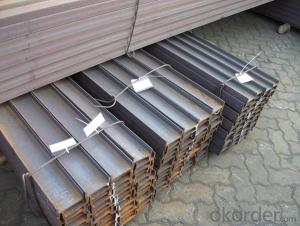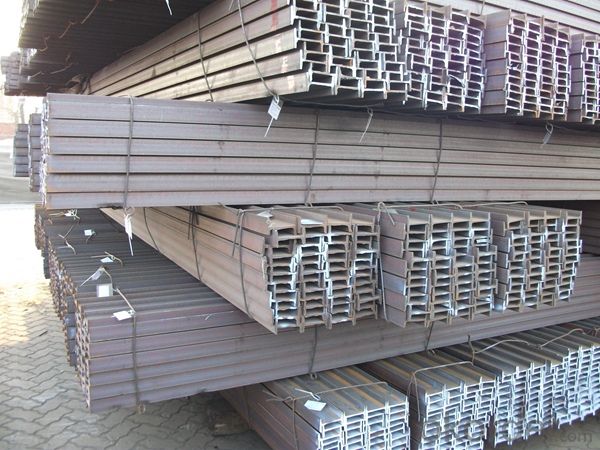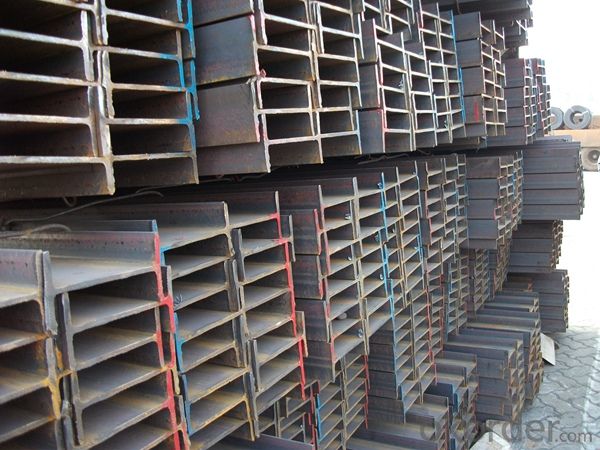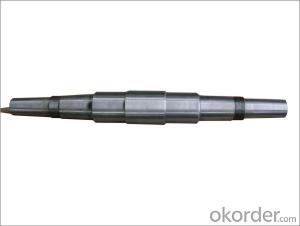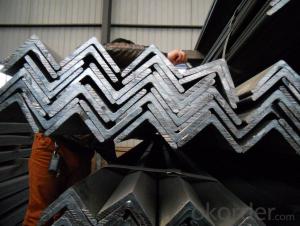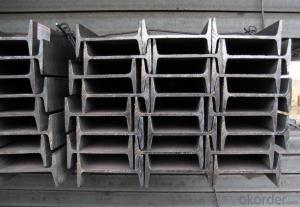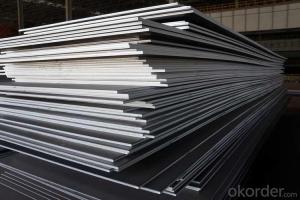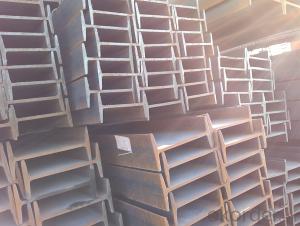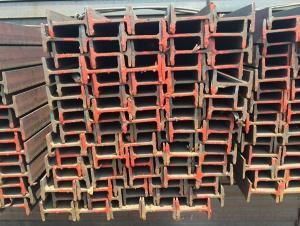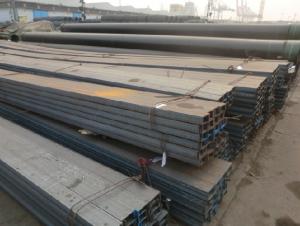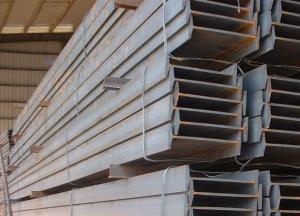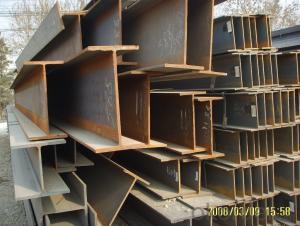High Quality Hot Rolled IPE Beams for Constrcution
- Loading Port:
- Tianjin
- Payment Terms:
- TT OR LC
- Min Order Qty:
- 25 m.t.
- Supply Capability:
- 200000 m.t./month
OKorder Service Pledge
OKorder Financial Service
You Might Also Like
Product Description:
OKorder is offering high quality Hot Rolled Steel I-Beams at great prices with worldwide shipping. Our supplier is a world-class manufacturer of steel, with our products utilized the world over. OKorder annually supplies products to European, North American and Asian markets. We provide quotations within 24 hours of receiving an inquiry and guarantee competitive prices.
Product Applications:
Hot Rolled Steel I-Beams are ideal for structural applications and are widely used in the construction of buildings and bridges, and the manufacturing, petrochemical, and transportation industries.
1. Supporting members, most commonly in the house raising industry to strengthen timber bears under houses. Transmission line towers, etc
2. Prefabricated structure
3. Medium scale bridges
4. It is widely used in various building structures and engineering structures such as roof beams, bridges, transmission towers, hoisting machinery and transport machinery, ships, industrial furnaces, reaction tower, container frame and warehouse etc.
Product Advantages:
OKorder's Steel I-Beams are durable, strong, and resist corrosion.
Main Product Features:
· Premium quality
· Prompt delivery & seaworthy packing (30 days after receiving deposit)
· Corrosion resistance
· Can be recycled and reused
· Mill test certification
· Professional Service
· Competitive pricing
Product Specifications:
1. Invoicing on theoretical weight or actual weight as customer request
2. Standard: EN10025, GB Standard, ASTM
3. Grade: Q235B, Q345B, SS400, ASTM A36, S235JR, S275JR
4. Length: 5.8M, 6M, 9M, 12M as following table
5. Sizes: 80mm-270mm
Dimensions(mm) | |||||
h | b | s | t | Mass Kg/m | |
IPE80 | 80 | 46 | 3.80 | 5.20 | 6.00 |
IPE100 | 100 | 55 | 4.10 | 5.70 | 8.10 |
IPE120 | 120 | 64 | 4.80 | 6.30 | 10.40 |
IPE140 | 140 | 73 | 4.70 | 6.90 | 12.90 |
IPE160 | 160 | 82 | 5.00 | 7.40 | 15.80 |
IPE180 | 180 | 91 | 5.30 | 8.00 | 18.80 |
IPE200 | 200 | 100 | 5.60 | 8.50 | 22.40 |
IPE220 | 220 | 110 | 5.90 | 9.20 | 26.20 |
IPE240 | 240 | 120 | 6.20 | 9.80 | 30.70 |
IPE270 | 270 | 135 | 6.60 | 10.20 | 36.10 |
FAQ:
Q1: Why buy Materials & Equipment from OKorder.com?
A1: All products offered byOKorder.com are carefully selected from China's most reliable manufacturing enterprises. Through its ISO certifications, OKorder.com adheres to the highest standards and a commitment to supply chain safety and customer satisfaction.
Q2: How do we guarantee the quality of our products?
A2: We have established an advanced quality management system which conducts strict quality tests at every step, from raw materials to the final product. At the same time, we provide extensive follow-up service assurances as required.
Q3: How soon can we receive the product after purchase?
A3: Within three days of placing an order, we will begin production. The specific shipping date is dependent upon international and government factors, but is typically 7 to 10 workdays.
Q4: What makes stainless steel stainless?
A4: Stainless steel must contain at least 10.5 % chromium. It is this element that reacts with the oxygen in the air to form a complex chrome-oxide surface layer that is invisible but strong enough to prevent further oxygen from "staining" (rusting) the surface. Higher levels of chromium and the addition of other alloying elements such as nickel and molybdenum enhance this surface layer and improve the corrosion resistance of the stainless material.
Q5: Can stainless steel rust?
A5: Stainless does not "rust" as you think of regular steel rusting with a red oxide on the surface that flakes off. If you see red rust it is probably due to some iron particles that have contaminated the surface of the stainless steel and it is these iron particles that are rusting. Look at the source of the rusting and see if you can remove it from the surface.
Images:
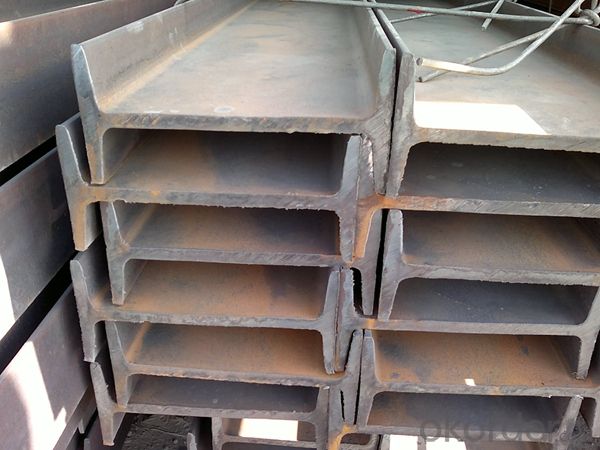
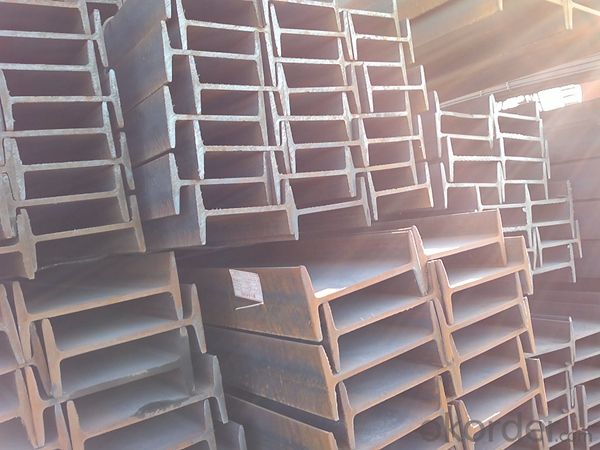
- Q: What are the different types of steel I-beam connections for lateral stability?
- There are several types of steel I-beam connections for lateral stability, including moment connections, shear connections, and bracing connections. Moment connections provide resistance against lateral forces by transferring moments between the beam and the supporting structure. Shear connections, on the other hand, resist lateral forces through the transfer of shear forces between the beam and the supporting structure. Bracing connections involve the use of braces or diagonal members to provide lateral stability by resisting forces in tension or compression. These various types of connections are crucial for ensuring the overall stability and structural integrity of steel I-beam systems.
- Q: Can Steel I-Beams be used for rooftop gardens?
- Rooftop gardens can certainly utilize steel I-beams. In fact, they are commonly employed as a structural support system for rooftop gardens in urban areas with limited space. Steel I-beams possess excellent strength and durability, enabling them to bear the weight of the garden, planters, soil, and any additional infrastructure like walkways or seating areas. Moreover, steel I-beams can easily be incorporated into the overall design of a rooftop garden, allowing for flexibility in constructing different levels or terraces. They also offer stability and resistance to weather conditions, ensuring the garden remains secure even during strong winds or heavy rain. However, it is crucial to note that the engineer or qualified professional should assess the specific design and load-bearing capacity of the steel I-beams to ensure they can safely support the intended rooftop garden. Local building codes and regulations should also be considered to ensure compliance and safety. In conclusion, steel I-beams provide a viable option for rooftop gardens, offering a sturdy and stable foundation for creating aesthetically pleasing and functional green spaces in urban environments.
- Q: Can steel I-beams be used in airport terminals?
- Yes, steel I-beams can be used in airport terminals. Steel I-beams are commonly used in the construction industry for their strength, durability, and versatility. They provide structural support and are often used to create the framework for large, open spaces such as airport terminals. The high load-bearing capacity of steel I-beams allows for the creation of large spans and open floor plans, which are essential in airport terminals to accommodate large crowds and provide flexibility for various facilities such as check-in counters, security areas, lounges, and retail spaces. Additionally, steel I-beams can withstand extreme weather conditions and offer fire-resistant properties, making them a suitable choice for airport terminals that prioritize safety and security.
- Q: What are the potential drawbacks of using steel I-beams?
- There are several potential drawbacks of using steel I-beams in construction projects. Firstly, steel is a heavy material, which means that the overall weight of the structure may increase significantly. This can result in additional costs for transportation and installation, as well as potential limitations in terms of the overall design and load-bearing capacity of the building. Secondly, steel I-beams are susceptible to corrosion if they are not properly protected. Exposure to moisture or harsh environmental conditions can lead to rusting, which weakens the structural integrity of the beams over time. Regular maintenance and protective coatings are necessary to mitigate this issue, which can add to the overall cost and effort required for upkeep. Furthermore, steel I-beams have a high thermal conductivity, meaning they can easily conduct heat or cold. This can lead to energy inefficiency as heat or cold is readily transferred through the beams, necessitating additional insulation measures to maintain comfortable indoor temperatures. These insulation requirements can add to the construction costs and potentially affect the overall energy efficiency of the building. Lastly, steel production has a significant environmental impact. The extraction and processing of raw materials for steel production can contribute to deforestation, habitat destruction, and greenhouse gas emissions. Additionally, the manufacturing process itself consumes vast amounts of energy and generates substantial carbon emissions. Therefore, the use of steel I-beams may not align with sustainable building practices and environmental goals. Overall, while steel I-beams offer excellent strength and durability, the potential drawbacks related to weight, corrosion, thermal conductivity, and environmental impact should be carefully considered before deciding to use them in construction projects.
- Q: How do steel I-beams contribute to the overall durability of a structure?
- There are several ways in which steel I-beams enhance the overall durability of a structure. To begin with, their unique shape, featuring a vertical web and horizontal flanges, offers a remarkable strength-to-weight ratio. As a result, they can bear heavy loads without excessive deflection or deformation, effectively distributing the weight of the structure and minimizing the risk of failure or collapse. Additionally, steel I-beams possess exceptional tensile and compressive strength, enabling them to withstand both pulling and pushing forces. This is especially crucial in areas prone to natural disasters like hurricanes or earthquakes, as these beams can absorb and distribute the energy generated by such events, preventing catastrophic failures. Moreover, steel I-beams exhibit high resistance to corrosion, which is essential for the long-term durability of a structure. These beams are often galvanized or coated with protective layers, effectively shielding them from rust and deterioration caused by moisture, chemicals, or environmental factors. Consequently, their strength and structural integrity remain intact over time. Furthermore, steel I-beams are easily fabricated and assembled, facilitating efficient construction processes. Their standardized sizes and shapes allow for accurate calculations and precise connections, reducing the likelihood of construction errors and ensuring a more durable structure. Lastly, steel I-beams boast a long lifespan, providing durability throughout the entire life of a structure. They do not deteriorate or weaken over time, making them a reliable choice for both residential and commercial buildings. Additionally, their recyclability contributes to the overall environmental durability of a structure, making them a sustainable option. In conclusion, steel I-beams significantly enhance the overall durability of a structure through their impressive strength-to-weight ratio, resistance to corrosion, ability to withstand various forces, ease of fabrication, and long lifespan. Their structural efficiency and reliability make them an indispensable component in constructing durable and resilient buildings.
- Q: Do steel I-beams require any special maintenance or care?
- Yes, steel I-beams do require some special maintenance and care to ensure their longevity and performance. Here are a few important considerations: 1. Regular Inspections: It is essential to conduct regular inspections of steel I-beams to identify any signs of corrosion, cracks, or structural damage. These inspections should be carried out by trained professionals who can assess the condition of the beams and recommend appropriate maintenance actions. 2. Cleaning: Steel I-beams should be cleaned periodically to remove any dirt, debris, or corrosive substances that may accumulate on their surfaces. Regular cleaning helps prevent corrosion and maintains the structural integrity of the beams. 3. Rust Prevention: Steel beams are susceptible to rust, especially if they are exposed to moisture or harsh environmental conditions. Applying a protective coating, such as paint or a specialized rust inhibitor, can help prevent corrosion and extend the lifespan of the beams. 4. Repairs: If any damage or deterioration is detected during inspections, prompt repairs should be carried out. This may involve welding, replacing damaged sections, or reinforcing weak areas to restore the structural integrity of the beams. 5. Load Monitoring: Steel I-beams should be monitored for excessive loads or changes in load distribution. Overloading can cause stress on the beams, leading to deformation or failure. Regular load monitoring ensures that the beams are not subjected to loads beyond their design capacity. 6. Professional Maintenance: It is advisable to consult with a structural engineer or a qualified professional for guidance on specific maintenance procedures and schedules for steel I-beams. They can provide expert advice and recommend appropriate maintenance practices based on the specific application and environmental conditions. By following these maintenance practices, steel I-beams can remain in good condition and continue to provide reliable structural support for a long time.
- Q: What does "I-beam 125A" mean?
- I-beam, also called steel girder, is a long strip steel with cross section.
- Q: What is the theoretical weight per metric ton of 30# I-beam?
- 30#a hot rolled I-beam 48.084kg/m, 30#b hot rolled I-beam 52.794kg/m.It is possible to use H steel instead of hot rolled i-beam. H steel is easy to process, more flexible in specifications and free from the standard type of hot-rolled i-beam. HM 300*200*8*12, 57.3kg/m weight meter.
- Q: What are the common methods of protecting steel I-beams from corrosion?
- There are several common methods of protecting steel I-beams from corrosion. One widely used method is the application of protective coatings. These coatings, such as epoxy, zinc, or polyurethane, create a barrier between the steel surface and the surrounding environment, preventing moisture and corrosive substances from reaching the beam. The coating can be applied through processes like painting, hot-dip galvanizing, or powder coating. Another effective method is the use of sacrificial anodes. These anodes, typically made of zinc or aluminum, are attached to the steel beam and corrode instead of the beam itself. By sacrificing themselves, the anodes prevent the steel from corroding. Regular inspection and replacement of sacrificial anodes are necessary to maintain the protection. Cathodic protection is another technique used to protect steel I-beams. It involves the use of an external power source that supplies a current to the steel beam. This current counteracts the natural electrochemical corrosion process by making the steel a cathode instead of an anode. This method is often used in conjunction with sacrificial anodes to enhance the protection against corrosion. Proper maintenance and regular cleaning are also essential for protecting steel I-beams from corrosion. Removing dirt, debris, and other contaminants from the surface of the beams can help prevent corrosion from occurring. Additionally, ensuring proper drainage and preventing the accumulation of water or moisture near the beams can also contribute to their protection. It is worth mentioning that the choice of protection method depends on factors such as the environment, budget, and intended use of the steel I-beams. Consulting with a corrosion specialist or a structural engineer can help determine the most suitable protection method based on specific requirements.
- Q: Are there any maintenance requirements for steel I-beams?
- Yes, there are maintenance requirements for steel I-beams. While steel is a durable material, it is still susceptible to certain factors that can affect its integrity over time. Regular maintenance is necessary to ensure the longevity and safety of steel I-beams. One important maintenance requirement for steel I-beams is inspection. Regular visual inspections should be conducted to identify any signs of damage or deterioration. This includes checking for cracks, corrosion, or any other structural issues that may compromise the strength of the I-beams. Inspections can help identify potential problems early on and allow for timely repairs or replacements. Another maintenance requirement is cleaning. Steel I-beams should be cleaned periodically to remove dirt, debris, or any corrosive substances that may have accumulated on the surface. Cleaning can be done using a mild detergent and water, or specialized cleaning solutions depending on the level of dirt or corrosion present. Regular cleaning helps prevent the buildup of contaminants that can accelerate corrosion or weaken the steel. Additionally, it is important to address any identified issues promptly. If any cracks, corrosion, or damage are found during inspections, it is crucial to take immediate action to repair or replace the affected I-beams. Ignoring or delaying repairs can lead to further deterioration and compromise the structural integrity of the steel beams. Furthermore, in some cases, steel I-beams may require protective coatings or paints to prevent corrosion. These coatings act as a barrier between the steel and its environment, preventing moisture or other corrosive elements from reaching the surface. The type and frequency of coating application may vary depending on the specific conditions and requirements of the application. In conclusion, regular inspection, cleaning, and prompt repairs or replacements are essential maintenance requirements for steel I-beams. By following these maintenance practices, the longevity and performance of steel I-beams can be ensured, ultimately contributing to the safety and durability of structures they support.
Send your message to us
High Quality Hot Rolled IPE Beams for Constrcution
- Loading Port:
- Tianjin
- Payment Terms:
- TT OR LC
- Min Order Qty:
- 25 m.t.
- Supply Capability:
- 200000 m.t./month
OKorder Service Pledge
OKorder Financial Service
Similar products
Hot products
Hot Searches
Related keywords
